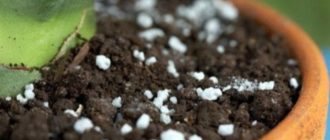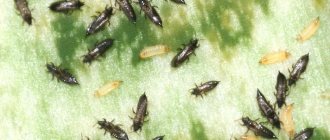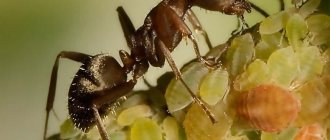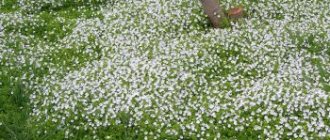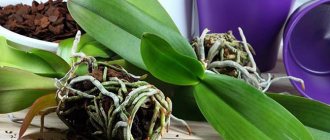Step-by-step instructions on how to get rid of various pests
Arachnoid
After detecting a spider mite on an orchid, you can get rid of it using several methods:
- Biological. It is enough to have several walls of predatory beetles that will destroy adult ticks.
- Chemical. Insecticidal preparations need to be alternated, as parasites develop immunity to the products used. In addition, a one-time treatment will not be enough; it will have to be carried out systematically. The following drugs are effective: Metaldehyde, Thiophos, Actellik.
- Folk. To combat spider mites, you can use a decoction of cyclamen roots. Pour water over the tubers, boil for 30 minutes, leave for 24 hours, and use the resulting filtered liquid to spray the orchid. Carry out treatment every 5 days 3-4 times. Simply wiping the orchid leaves with a cloth soaked in alcohol will help get rid of spider mites.
We invite you to watch a video on how to get rid of spider mites:
Bulbous
As soon as this pest is discovered, it is necessary to immediately change the soil in the pot. You can get rid of bulb mite in the following ways:
- Folk. Using folk remedies is effective only at the early stage of the infection, when the mites have not spread much. A solution of laundry soap is suitable (20 g of raw materials per 1 liter of water). You can use it to wipe orchids or immerse the flower completely in the solution. You can try spraying the plant with a weak solution of potassium permanganate.
- Chemical. Flower growers use general-spectrum insecticides.
But you can also use highly specialized drugs that will only fight ticks - these are acaricides. To prepare the solution, you need to use the instructions indicated on the package. The concentration can be made weaker, but not stronger, otherwise the opposite effect is possible. It is necessary to soak the flower in the prepared solution, and send the roots back into the soil only when they are completely dry.
Root
This parasite is the most difficult and tenacious to remove. It has a high ability to recover and reproduce. If a root mite is noticeable on the orchid, then all affected parts of the flower must be urgently removed, and the cut areas must be treated with activated carbon powder. Affected plants must be isolated from other healthy ones. Throw away the soil immediately and disinfect the pot.
Folk remedies suggest using a nettle decoction, which will not only eliminate pests, but also increase the flower’s immunity.
To prepare the solution, you need to: take 700 g of fresh herb, pour 5 liters of boiling water and leave for 30 minutes in a dark place.
How to treat a plant? This is done within 5 minutes, immersing the entire orchid in the broth. Of the chemical preparations, ascaricides remain effective. You can also use the insectoacaricidal agent Acaritox against pests. Use it strictly according to the instructions, and the frequency of treatment is every 5-7 days.
Biological products are also effective against root mites:
- Verticillin;
- Summer resident;
- Nematophagin.
Flat beetle
To quickly and effectively get rid of the parasite, it is better to immediately use chemicals - acaricides. Since mites are not insects, it is useless to use insecticides.
Most often used:
- Actofik;
- Fitoverm;
- Vermitek.
You can use folk remedies that were given earlier, but they are only effective at the early stage of infection.
Armored
This parasite lives underground, so you need to get rid of it as quickly as possible. To do this, the first step is to remove the flower from the soil and soak the root system in water for half an hour.
3-5 minutes after diving, you will see the parasites begin to emerge. After half an hour, remove the root system from the water and lay it down to dry. Carry out activities 2-3 times to get maximum results. When the roots are dry, you can transplant the plant into new soil. If you use chemical control methods, then acaricidal drugs are effective, including:
- Karbofos;
- Sumiton;
- Aktellik
In the store you can buy a predatory mite - Hypoasmis myles. One package will be enough to completely get rid of parasites.
From the video you can learn how to get rid of armored mites:
Description of ticks and their types
The spider mite (Tetranychus urticae) belongs to the genus of arachnids and includes over 1000 species of arthropods that are distributed throughout the planet, except Antarctica. Of all the species, only 35 parasitize Orchids. Appearance of the insect:
- the body of the arthropod is oval, up to 1 mm in length;
- each species has its own color from yellow-green to red-brown, sometimes whitish;
- there are specimens with 2 dark spots on the body;
- type of oral apparatus – piercing-sucking;
- adults have 4 pairs of legs, larvae - 3 pairs;
- The antennae that most insects have are absent in mites.
The plant can also be affected by other types of mites, such as false spider mites and flat beetles. They require a different environment to reproduce. Types of parasites most often found on plants:
- Ordinary . The body of the insect is soft, flat below, slightly convex above. The size of females is 0.4-0.6 mm, males - 0.3-0.45 mm. The color of the larvae is green or brown, transparent. They have 6 legs; as they mature, their number increases to 8, and their color changes to orange or red.
- Armored . The size of the insect is 0.7-0.9 mm, the color is black or dark brown. The parasite lives in the ground, lays eggs on rotten root systems and fallen leaves, although it runs throughout the orchid. It feeds on dead parts of the plant, so it is sometimes useful. It runs fast, and while moving, many different microorganisms accumulate on its paws and body, which can have a detrimental effect on a houseplant. Oribatid mites do not like light, so they always hide.
- Oncidium (flat) . The body length of the arachnids is 0.3 mm, the shape is ovoid, the color is orange or red. The color of the eggs is red. The insect not only damages the leaf blade, but also injects poisonous saliva into the leaf epithelium.
- Carmine . The body shape of the insect is ellipsoidal, the color is burgundy or brown. Nymphs can be recognized by their yellow and light green shades. The color of the larvae and eggs is red.
- Turkestan . This species is similar in external structure and size to the common tick. Its color varies from yellow to green shades. With the arrival of spring and autumn, the color of the females acquires a bright red hue.
- Greenhouse flat beetle . Red flat mite is what orchid growers call it because the nymphs, larvae and eggs can be any shade of red. The body shape of an adult is ovoid, the color is dark red. The back is covered with a honeycomb pattern.
- Phalaenopsis flat beetle . Due to its small size, the flat beetle is practically invisible. Hides in the axils and folds of leaf plates, on the root system. It affects not only phalaenopsis, but also other Orchid species. The size of males does not exceed 0.27 mm, females - 0.3 mm. Unlike the greenhouse flat beetle, it has 2 antenna-shaped bristles, which are located on the back of the abdomen. The eggs and larvae are red.
- Bulbous . It is impossible to detect the pest, since it affects the root system of the plant or lives at the very base of the stem. The body shape of the arthropod is oval, the color is white or pale yellow. The legs are strong and brown.
Note! You can distinguish spider mites from flat ones by their anatomical structure. The body of flat arthropods is divided by transverse scars and consists of 3 parts: anterior, middle, posterior.
Disease prevention
To prevent mites from appearing on orchids, the following preventive measures must be observed:
- Periodically dry the soil in which the flower grows.
- Spray the flower in a timely manner and ensure that drops of liquid do not stagnate in the axils of the leaves. Otherwise, the orchid will rot.
- Maintain the optimal watering regime.
- Ticks appear in rooms with dry air. You can increase the humidity by placing a container of water at room temperature near the orchid for 2 days. The water will evaporate and the air will become humidified.
After infection with small insects, white or other bugs, mealybugs, scale insects or midges, the orchid begins to slowly die. Regular inspection of all parts, careful care, and regular preventive treatments will help to protect the plant.
Caring for an orchid is very difficult, especially when it comes to pest control. The difficulty is that the flower is attacked by small parasites such as mites. It is not always possible to see them immediately and eliminate them in a timely manner, so you have to resort to more aggressive methods of control when the accumulation of pests is already massive.
Insect activity
Ticks got their name from the art of weaving webs. Another species of arthropod does not have this ability. Because of this, they began to be called false or red ticks (Tenuipalpus pacificus). Arachnids feed on plant sap. They bite through the leaf, inject a special liquid inside it, which, when it enters the epithelium of the leaf membrane, forms a nutritious juice. This activity of mites is reflected on plant leaves as follows:
- they gradually turn yellow;
- sometimes small translucent dots appear on the surface of the leaf plate;
- the leaf begins to rot or dry out.
The more greenery an orchid loses, the worse photosynthesis becomes. The development process slows down, then stops and after some time the plant dies. In addition, the appearance of the flower deteriorates greatly if a colony of pests instead of leaves attacks the peduncles.
Conditions for reproduction
For arachnids to reproduce, temperatures above 25 degrees, dry air and a humidity level of up to 40% are required. Ticks go through 5 stages of development :
- The female lays eggs in groups of 200 each. The number of groups may vary. The eggs are round in shape and have a diameter of 0.15 mm. The masonry is located in different places. Usually this is the root system of plants, the underside of leaves, even the walls of the pot and the windowsill.
- After 3 days, a pink larva appears. It is slightly larger than an egg and has 6 legs. The arthropod remains in this stage for 24 hours.
- Then comes the nymph stage. A female individual goes through 3 molts and 2 periods of development, a male – 3 moults and 1-2 periods of development.
- After 7 days, the larva turns into an imago (adult) and is ready to reproduce. The female is slightly larger than the male.
The lifespan of the parasite lasts 15-30 days, if environmental conditions contribute to this. At a temperature of 20 °C, the arachnid will need up to 20 days to develop. The warmer the room, the faster the adult insect appears. The development stage takes no more than 8 days at air temperatures from +25 to +30 °C. Flat beetles do not require special conditions for reproduction if they are in closed ground. Their development occurs all year round.
Important! If the conditions in which the egg laying is poor, the development process is suspended. Their vital functions can be restored again even after 4-5 years.
Hitting the house
Penetration of arachnids into a human home occurs in different ways:
- with a new plant brought from a flower shop;
- through soil contaminated with eggs and larvae;
- through street clothes;
- Sometimes insects fly into the house on a cobweb through an open window.
Which parts of the flower are affected?
Depending on the family, mites settle in the substrate, on leaf blades, or at the growing point. Active life activity harms green mass, buds, peduncles, flowers, and roots.
Types of damage:
- in places of bites, the leaves lose juice along with chlorophyll cells. The damage gradually spreads to the entire flower, the plates acquire a marbled coating, turn brown, and finally dry out;
- living in the substrate, damage the root system. Feeding on plant tissue, large colonies turn roots into dust.
Peculiarity! A pest is a carrier of bacteria, fungi, and viruses. Along with damage from their vital activity, infectious lesions develop. The first sign is wet spots on the foliage.
Biological characteristics
Ticks are part of the arachnid family, numbering more than 54 thousand species. They have microscopic dimensions and settle mainly in the upper soil layers, rich in decomposing organic matter.
General description:
- the body is solid or consists of divided parts with a border closer to the front, length 0.2-0.4 mm;
- there is a protective cover in the form of a chitinous shell or a hard shield;
- usually 6 pairs of legs, 4 of which are hind legs with claws and stalked suckers, a pair of anterior claw-shaped chelicerae, forming a piercing-cutting oral structure, a pair of pedipalps (legs) included in the structure of the oral organ.
Varieties
Most mites are free-living, non-parasitic saprophages that feed on decaying organic matter. However, there are varieties that parasitize vegetation, pose a veterinary hazard to animals and transmit diseases to humans.
The following appear on orchids:
- armored - prefers to settle in the soil, feeding on rotting parts of plants;
- false, or white cobweb - entangles the vegetative mass of the orchid with a thin white web;
- flat-bodied - the body is oval, flattened, bristly, yellow-red in color;
- root - has increased endurance, maintaining viability without nutrition for a long time, feeds on organic residues and underground plant parts, very dangerous for orchids, because often invisible;
- red spider - considered the most dangerous, because is immune to the effects of chemical agents, color - in shades of yellow-red;
- bulbous - settles mainly on pseudobulbs, brown in color;
- phalaenopsis - most often affects phalaenopsis in shaded places (leaf axils, near the base of peduncles, at the roots), but is able to reproduce on other orchid varieties, the color is red;
- greenhouse - looks like phalaenopsis, but differs from the latter in its flat-bodied structure with a terracotta base color and a mesh pattern.
How to deal with them?
To get rid of spider mites and other types of mites at home, you should take a number of effective measures. First of all, it is necessary to disinfect the affected area. You should use diluted laundry soap: one large spoon of liquid soap is mixed in one liter of water. Using a cloth or sponge, gently wipe the surface of the plant.
It is important that the soap solution does not get on the ground, otherwise the root system will be damaged. The tray and pot should be wiped with a disinfectant solution, and if the orchid is on the windowsill, then it is also advisable to wipe all the surfaces around with a soap solution.
After this, you should pour the substrate, cover the plant with a transparent film, and keep it in this form for at least 70 hours. The film increases the percentage of humidity, which promotes the active annihilation of insects and can cure the plant. It is important to remember that the orchid is afraid of direct sunlight; the flower should be kept in the shade.
Pests on indoor plants are always a nuisance and additional trouble for the gardener. Spider mites on an orchid are a special problem, because the pest arthropod is very small in size, and it is very difficult to notice it without a magnifying glass. Sometimes it becomes clear about the presence of ticks after a significant increase in the colony of parasites, forming up to 20 generations per season under favorable conditions.
Reasons for appearance
Infection of orchids occurs by air. With wind currents, larvae and adults penetrate into open windows. Insects are also carried on clothing, household items, and together with newly acquired infected indoor flowers or undisinfected soil.
Active reproduction is observed at relatively low humidity up to 30-45%. In order for a larva to appear, dry air requires a high temperature of 25-30°C.
The warmer it is, the shorter the life cycle of the pest from egg to adult.
Ways to combat ticks
Experienced orchid growers advise that immediately after discovering uninvited guests, isolate the affected plant in a separate room, away from the entire collection of orchids, for which the air humidity is increased if you are completely sure that they are affected by spider mites and not by another type of mite.
First of all, the flower must be washed with soapy water to remove those individuals that have not yet had time to attach themselves to the leaf tissues. Many gardeners wipe the leaves of orchids with a cotton swab dipped in alcohol, but for plants with thin-skinned leaf blades and young specimens with delicate foliage, such an action is not suitable - it can result in a burn from the alcohol.
Next, a method of destroying parasites is selected depending on their number on the flower - in case of small damage, gentle folk recipes can be a salvation; in case of numerous colonies, chemical preparations are used immediately as they are more effective.
Folk remedies
To combat mites on indoor flowers, folk methods of combating the parasite are used - decoctions and infusions of insecticidal plants:
- Decoction of cyclamen tubers. Cyclamen tubers are cut into pieces and boiled in boiling water for about 40 minutes, then left for a day and filtered. Spray orchids at intervals of 5 days.
- Onion infusion. 15 g of chopped onion or 6 g of husk per 1 liter of water are infused for 6–7 hours in a closed container.
- Dandelion root infusion. 20–30 g of finely chopped dandelion roots, sold in any pharmacy, are infused for a couple of hours in 1 liter of water at room temperature.
- Concentrated garlic infusion. 170 g of cloves, crushed in a garlic press, are infused for 5 days in 1 liter of water poured into a dark, tightly sealed container. To prepare the solution, use 6 g of infusion per 1 liter of water, spray the orchids several times with an interval of 4–5 days.
Advice! On one of the forums, orchid growers eagerly discussed methods of getting rid of mites. One of the experienced owners of an orchid collection shared an unexpectedly simple method of prevention - she pokes garlic cloves into the orchid substrate. Some of them germinate, but the flowers do not suffer from such proximity. But in 15 years of growing orchids, the author of the advice has not observed any menagerie.
Chemicals
How to treat the affected plant if time is lost and the pest produces offspring, increasing the population size? How to get rid of spider mites on orchids?
Experts advise using the most gentle chemicals of the avermectin group in apartment conditions - Actelik, Fitoverm, Actofite, Vermitek and others. However, these drugs do not affect eggs and non-feeding larvae and protonymphs, so repeated 1 or 2 treatments after 9–10 days are necessary if the ambient temperature is low, within 20–25 degrees.
At higher thermometer readings, approaching 30 degrees, 3-4 sprayings are needed at intervals of 3-4 days. In addition to the plants, the substrate and the window sill or stand where the mite-affected plant was located are also treated.
Attention should be paid to the fact that spider mites quickly develop immunity against chemicals, which means it is necessary to change the product every time you re-treat.
In addition to the above mentioned, flat beetles are also sprayed with other drugs - fozalon, ambush, acrex, tsimbush, diluted in a concentration of 0.05–0.08%. It is especially difficult to get rid of the phalaenopsis flat mite, since the pest hides in places where the solution simply does not reach. In addition, it makes nests with oviposition between the roots. Even after several treatments, the hatched larvae continue to crawl out of them.
The Phalaenopsis platy boletus cannot be destroyed by enteric contact agents, and there are practically no systemic acaricides that are harmless to humans and allowed in apartment conditions.
The fight against it sometimes lasts for months, or even years, so this is an exceptional case when it is better to use once, but a strong product from the carbamate group, which has systemic acaricidal properties, for example, the least dangerous for the human body Marshall, a pro-insecticide with an active substance carbosulfan. However, processing should be carried out in a non-residential area, observing all necessary safety measures when working with toxic substances.
The manufacturer warns that carbosulfan is a liquid substance and cannot be found in dry form, so all kinds of powders are an obvious fake.
Preventive measures
To prevent the orchid from being re-invaded by parasites, it is necessary to follow simple preventive measures to care for the plant. Basic Rules:
- The new orchid is kept in quarantine for 14 days, only then placed with the rest of the plants. At the same time, it is treated with an insecticide against insects with which it may be infected.
- You should not take soil for flowers in a flower bed in the yard; parasite larvae often live in such soil. Substrate for phalaenopsis must be purchased in the store. It is of good quality and is disinfected.
- Several times a week, the orchid is inspected for pests, and the leaf blades and trunk are wiped with a disinfectant solution.
- Plants should not stand close to each other, otherwise parasites will appear in them.
- It is necessary to regularly ventilate the room.
- Do not over-moisten the substrate or allow it to dry out completely.
- You need to water the orchid so that no drops of water remain on the inflorescences.
- The air in the room should always be humid.
- Remove fallen leaves and flowers in a timely manner.
Most often, weakened plants suffer from insect attacks. Due to poor care or unsuitable environmental conditions, their immunity decreases, after which the orchid becomes ill. Therefore, before purchasing a plant from the Orchid family, it is necessary to study its physiological characteristics and find out what kind of environment it requires.

